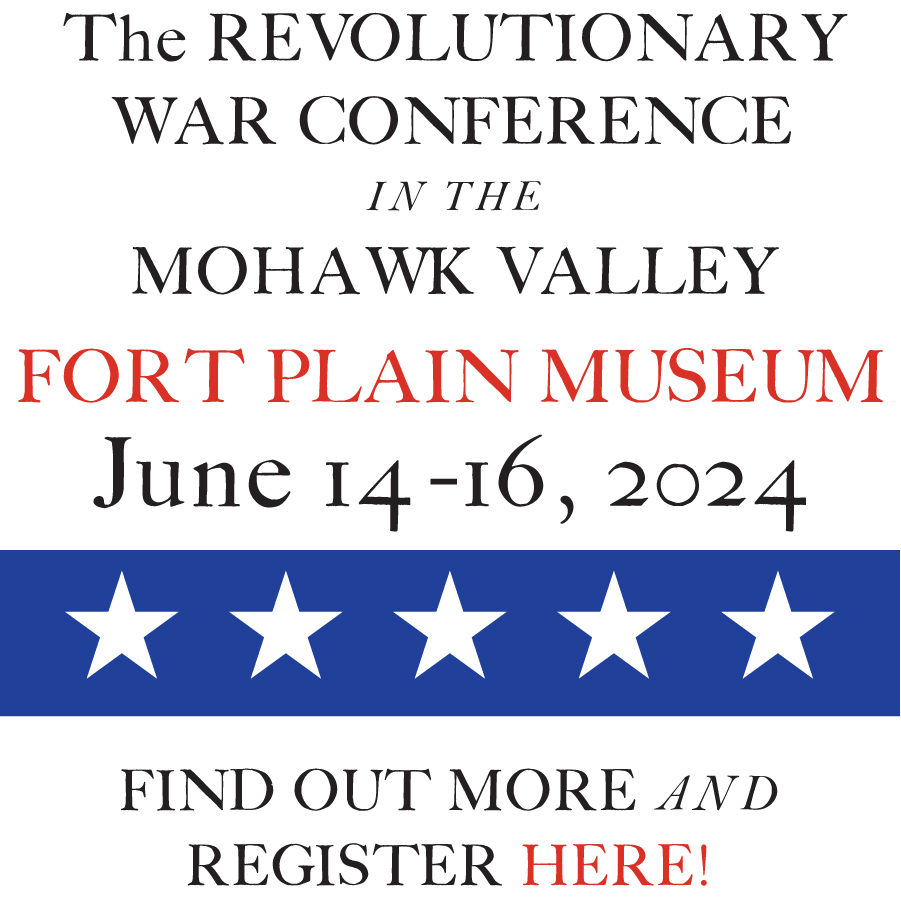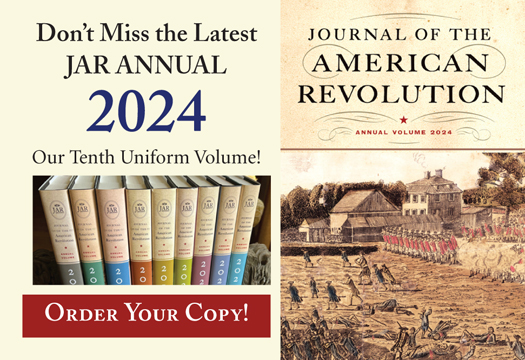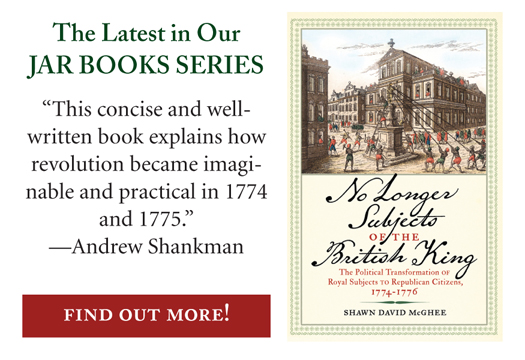BOOK REVIEW: The Great New York Fire of 1776: A Lost Story of the American Revolution by Benjamin L. Carp. (New Haven: Yale University Press, 2023)
Questioning long-held beliefs about historical events and their causes creates the most notable monographs among the bounteous publications concerning the Revolutionary-era each year. Prominent recent examples include adding women and their contributions to the wartime stories of Admiral Richard Howe and General William Howe and depicting King George III as more than mad and not as a tyrant. Benjamin Carp’s new book adds to this impressive list by postulating a controversial but well-supported new ignition theory for the mysterious 1776 New York City fire, which consumed a fifth of the metropolis shortly after its capture by British forces.[1]
An expert on Revolutionary Era urban life, Carp argues that Rebel arsonists intentionally set the inferno, countering many eminent historians who assert the fire was accidental or occurred through unknown causes (page 254). Supporting his arguments are many British and American voices extracted from primary sources, including those typically underrepresented, such as enslaved people, free blacks, and women. With lawyer-like precision, Carp lays out his case, principally through first-hand accounts from British and Loyalist sources and alleged Rebel arsonists. Then, through meticulous research, he identifies over ten ignition points and many other locations where residents uncovered combustible materials. Finally, Carp provides a detailed street map supporting his thesis, identifying burned areas, ignition points, incendiaries, and witnesses.
As the initial fire investigators did not preserve evidence and record witness depositions, Carp allows that his proposition does not achieve the standard of “beyond a reasonable doubt” as in a criminal case. However, in a compelling conclusion chapter, he postulates that fourteen different interpretations of the facts would have to be true for the fire to be deemed an accident. As a result, Carp argues that the preponderance of evidence indicates that Rebels set the fire and fanned its flames. He believes a bevy of reasons motivated the Rebel arsonists, including attacking wealthy Loyalists’ property, destroying Anglican churches, stopping the British army, disrupting the occupation, and destroying valuable British military assets (p. 246).
Carp addresses previous historical interpretations and skeptics by demonstrating more proof for an arsonist-initiated fire. In his view, the historian’s job is to assert the cause for which there is the most substantiation. His evidence supporting Rebel culpability includes Rebel threats to burn the city, fire chiefs who buried their valuables, combustible materials found before and after the fire, multiple witnesses testifying that fires broke out at several places at once, suspects caught “red-handed” with combustibles, and the confession of one Rebel arsonist. He argues that this evidence is sufficient to assert that Rebels deliberately set the fire (p. 243-4).
While Carp assigns responsibility for the fire to the Rebels, he offers that the conflagration was not the Britishers’ “finest hour.” Upon encountering suspected torchers, British soldiers conducted extralegal executions. While the numbers are not precise, Carp asserts that at least eight men and women lost their lives at the hands of the British army and Loyalist supporters. Additionally, Royal authorities were embarrassed by their inability to maintain order and safety, as the blaze occurred eight days after the Rebels abandoned the city.
In recounting the New York fire story, Carp highlights the little-remembered but captivating actions of a Rebel spy, Abraham Patten. Eight months after the fire, British authorities discovered Patten’s espionage in New Brunswick, New Jersey, and arrested him. Before his execution, Patten confessed to several intelligence-gathering and sabotage activities, including his principal role in kindling the New York fire. Curiously, upon learning of Patten’s hanging, Washington sent John Hancock a letter indicating that Patten “conducted himself with great fidelity to our cause.” Carp opines that Patten’s confession and Washington’s praise are indications that Washington and Congress endorsed the burning of New York City (p, 197-8). British observers reported that Patten exhibited great courage and eloquence while facing the gallows, and Carp wistfully concludes, “There are statues for [Nathan] Hale, but none for Patten” despite conducting similar spying missions and each comporting themselves with eloquence on the scaffold (p. 248).
After the fact, neither side wished for a complete and impartial investigation into the fire’s origin. The British commander, Gen. William Howe, did not want to be held accountable for the prodigious property destruction under his watch. He ordered the first investigation by subordinates who held a secret court of inquiry trial. Unfortunately, General Howe either destroyed the trial records to avoid any after-the-fact criticisms or an 1826 fire in his Irish residence consumed them. Additionally, Howe may have suppressed evidence that his soldiers had committed heinous summary executions. Likewise, General Washington and other Rebel leaders sought to avoid angering New Yorkers by denying any involvement in setting the fires. Washington sent a letter to General Howe asserting that the arsonist activities were unknown to him (p. 172). After each side publicly blamed the other in an exchange of letters, the British and Rebels resumed combat operations and dropped the subject.
Additionally, Carp opines that after the 1776 fire, the Rebels avoided arson and other destructive activities to paint the British as the terrorizing side. Subsequently, the Rebels did not destroy cities that they lost or abandoned to the British, notably, none in the vicious southern campaigns. However, the British continued to burn and destroy American cities such as Danbury, Connecticut, and Kingston, New York, which Carp believes discouraged Americans from reconciling with Britain (p. 210). Finally, while the Rebels may have abandoned arson as a military tactic, Carp cautions that the Revolutionary War was not “moderate, restrained, and civilized” but was “often destructive and riven with unrestrained violence” (p. 213).
Carp points out that, for unknown reasons, one of the last British acts before evacuating New York City in 1783 was to hold a second inquiry into the causes of the fire. Ordered by then-commander-in-chief Gen. Guy Carleton, the tribunal, much like Howe’s earlier effort, failed to shed additional light on the arsonists and their motivations. Numerous witnesses were unavailable, and those that testified exhibited faulty memories after a seven-year lapse. Again, Carleton’s inquiry concluded that the Rebels had set the fires but did not produce unassailable proof. Not interested in making the fire an issue, neither Carleton’s superiors nor the Americans paid attention to this second inquiry.
Moving into a memory of history chapter, Carp believes that both sides had reasons to deemphasize the fire from peoples’ consciousness. Focusing on nation-building, the Americans did not want to revisit actions that could be construed as terroristic or lawless. Likewise, the British did not wish its armed occupation to be associated with summary executions or heedless negligence. Additionally, neither side wanted to be viewed as committing “war crimes.” Finally, New Yorkers aspired to erase their city’s Rebel versus Loyalists divisions. Carp concludes, “forgetting the Great Fire became essential to building an American nation that would be acceptable among the community of nations (p. 234).”
Criticisms of the book are minor and do not detract from the author’s thesis. While the book’s maps are outstanding, Carp describes the fire as having two tongues, but these are not depicted, which would have aided reader comprehension. Additionally, Carp only briefly addresses plundering by Crown forces and residents, an issue raised by previous historians.[2] Further, Carp’s conclusions missed an opportunity to let readers know that, notwithstanding the post-New York fire Revolutionary War experience, wanton destruction by fire remained an American and British military tactic, as evidenced by the burning of Buffalo, York, and Washington, DC, in the War of 1812. Finally, accidental urban fires plagued New York in the nineteenth century, with 1835 and 1845 conflagrations on the order of the 1776 fire.
I recommend Benjamin Carp’s book to aspiring historians and others as an example of challenging long-accepted interpretations to discover new insights and improved understandings. Too often, generally accepted “settled history” is, after fresh scrutiny, inaccurate or misleading. Carp’s work exhibits the creativity and fortitude to take on established historical interpretations to discern new understandings of important historical events and their causes.
PLEASE CONSIDER PURCHASING THIS BOOK FROM AMAZON IN CLOTH OR KINDLE. (As an Amazon Associate, JAR earns from qualifying purchases. This helps toward providing our content free of charge.)
[1]Carp sharpens and deepens his analysis of the 1776 New York City fire first addressed in 2006, Benjamin L Carp, “The Night the Yankees Burned Broadway: The New York City Fire of 1776,” Early American Studies4, no. 2 (2006): 471–511.
[2]Barnet Schecter, The Battle for New York: The City at the Heart of the American Revolution (New York: Walker & Co, 2002), 207.













8 Comments
It is so refreshing to see researchers using the primary sources over the secondary. It is also nice to see another historian looking at legal standards of proof to decide whether or not an event occurred as earlier writers described.
The rebels may not have committed sufficient acts to allow a jury to find by proof beyond a reasonable doubt they were criminal in nature, but in doing so by a preponderance of the evidence they would still be liable in a civil court; albeit, the British exercise of “street justice” (also called club law) on suspects made any trials irrelevant.
You may just be using criminal and civil courts as modern day examples but it’s worth nothing that the British kept Manhattan under martial law for the rest of the occupation (until 1783) so there were no civil trials to be had for quite some time.
Notwithstanding martial law, elsewhere in the colonies the level of evidence needed to convict in a criminal trial or to find liability in a civil context was the same before and after the Revolution as it is today (see my book, Rebel and Tory, for further information).
Fascinating. Thanks, Gene. I was agnostic about reading this one, in part because I suspected the record was so mixed as to preclude a reasonably conclusion. But now it’s on my list, largely due to your early focus on Carp’s methodology, which sounds about as rigorous as one can be.
Truth be told, I always suspected an implicit scorched earth mindset among some Americans combined with initial British indifference and the chaos that always accompanies a nascent occupation.
Your suspicions about a “mixed” record are well founded. Several early compilations of the evidence (Valentine’s Manual, Henry P. Johnson’s Campaign of 1776, and Stokes’s Iconography of Manhattan Island) all presented such a variety of primary sources that I think a lot of historians have been scared away from offering a definitive conclusion.
Eric, you will enjoy Benjamin Carp’s analysis.
Additionally, centralized command and control and discipline over Rebel forces and leaders did not exist after the chaotic Rebel retreat from the city. Carp points out that while Washington may had some involvement, small groups of active and former soldiers and other individuals may have acted on their own in starting the conflagration. Your point that “some Americans” sought a scorched earth retreat is a good one.
Your talk in Williamsburg this past weekend was great! Thanks for all you do!
Kim Burdick
ARRT-NDE
A model book review Gene well done. Benjamin in his book discusses the possibility that Washington secretly ordered the fires but the author prudently does not go overboard on the point and handles it just right in my view. I look forward to reading the rest of Benjamin’s book.